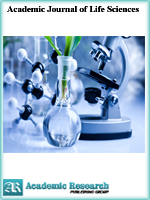Academic Journal of Life Sciences
Online ISSN: 2415-2137
Print ISSN: 2415-5217
Print ISSN: 2415-5217
Quarterly Published (4 Issues Per Year)

Archives
Volume 6 Number 8 December 2020
Albizia Lebbeck Stem Bark Aqueous Extract as Alternative to Antibiotic Feed Additives in Broiler Chicks Diets: Haematology Serum Indices and Oxidative Status
Authors: Alagbe J. O. ; Ajagbe A. D. ; Attama Jeremiah ; Philemon K. C. ; Bello Kamoru A.
Pages: 108-115
DOI: doi.org/10.32861/ajls.68.108.115
Abstract
A total of Three hundred and seventy five (375) one day old (Ross 308) broiler chicks with mixed sex were used to examine the effects of Albizia lebbeck stem bark (ATSM) aqueous extract as alternative to antibiotic feed additives in broiler chicks diets: haematology, serum biochemical indices and oxidative status. Birds were divided to five treatments with five replicates of fifteen (15) birds in a completely randomized design. Treatment 1 (basal diet + 0 % ATSM), treatment 2 (basal diet +1.2 grams Oxytetracycline per litre of water), treatment 3 (basal diet + 10 ml ATSM per liter of water), treatment 4 (basal diet + 20 ml ATSM per litre of water) and treatment 5 (basal diet + 30 ml ATSM per liter of water) and the trial lasted for 56 days. Results on some haematological parameters revealed that red blood cell (RBC), pack cell volume (PCV), haemoglobin (Hb), mean corpuscular volume (MCV), mean corpuscular haemoglobin (MCH), mean corpuscular haemoglobin concentration (MCHC), white blood cell (WBC) and its differentials were significantly ((P<0.05) different among the treatments. Total protein, glucose, urea, cholesterol, creatinine, aspartate aminotransaminase (AST) and alanine aminotransferase (ALT) were significantly ((P<0.05) affected by ATSM. Activities of superoxide dismutase (SDA), glutathione peroxidase (GPx), catalase (CAT) and malonyldialdehyde (MLA) were significantly influenced by ATSM (P<0.05). It was concluded that ATSM could be administered to broiler chicks at 30 ml/litre without any negative effect on the general performance of birds.
In Vivo and in Vitro Anti-Inflammatory Activities of Extracts of Pandiaka angustifolia (Vahl.) Hepper (Amaranthaceae) Used in Traditional Medicine in Burkina Faso
Authors: Emmanuel A. M. Thiombiano ; Mindiédiba Jean Bangou ; Yougbaré-Ziébrou Mouhibatou ; Martin Kiendrebeogo
Pages: 101-107
DOI: doi.org/10.32861/ajls.68.101.107
Abstract
Background: Pandiaka angustifolia Valh Hepper (Amaranthaceae) whole plant is used in folk Burkinabe’s medicine to treat ailments with an inflammatory component. Previous studies revealed the antioxidant capacity, xanthine oxidase, and lipoxygenase inhibitory activities of the plant, but to the best of our knowledge, its anti-inflammatory activities were not reported before. Therefore, this study was designed to evaluate the anti-inflammatory and analgesic activity of P. Angustifolia hexane and aqueous extracts using in vitro enzymatic methods and in vivo methods and verify the best anti-inflammatory extract implication in KATP pathways. Experiments: acute toxicity of the plant was conducted under OECD 423 guidelines. Phospholipase and cyclooxygenases were pro-inflammatory enzymes used to evaluate in vitro anti-inflammatory effects of plant extracts while carrageenan induced edema method was used to evaluate the anti-edematous activity and acetic acid inducing writhing method to evaluate the non-morphine analgesic effect of herbal mixture. ATP sensitive K+ channel assay was performed in vivo using the glibenclamide as ATP-sensitive potassium channel (KATP) blocker. Results: enzymatic inhibition assays revealed that both hexane and aqueous extracts of P. angustifolia were good inhibitors against sPLA2 activity with IC50 values of 14.23 ± 0. 72 µg/mL and 11.56 ± 0.11 µg/mL, respectively. Aqueous extract presented the best inhibition for COX-1 (IC50 = 24.76 ±0. 51 µg/mL) while hexane extract concentration that inhibit 50% of COX-2 was lesser than those of aqueous extract. P. angustifolia aqueous extract orally administrated to NMRI mice caused no death at the dose of 3000 mg/kg b.w indicating that the plant toxicity is low. While hexane extract was unable to reduce Carrageenan-induced edema, ethanolic extract were significantly active when extract was orally administrated. Non-morphine analgesic activity evaluation revealed that ethanolic extract was more efficient on writhing reduction than hexane extract. Nociception effect of the plant is linked with its effects on K+ ATP sensitive channels. Conclusion: Results indicate that the anti-inflammatory potential of P. angustifolia may be due to its polar phytoconstituents and observed pharmacological activities provide the scientific basis for the medicinal use of the plant in the treatment of ailment associated with inflammation.



